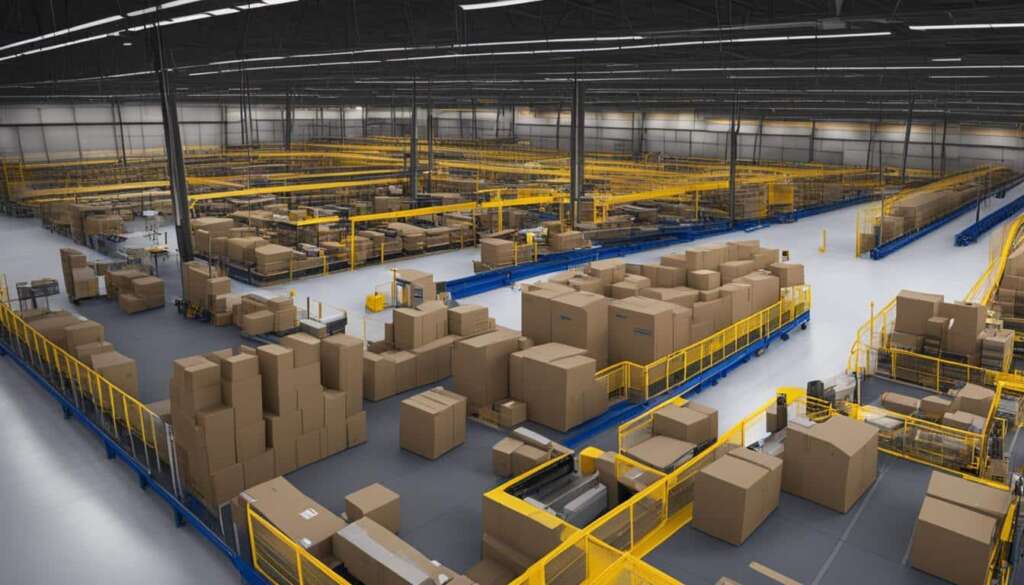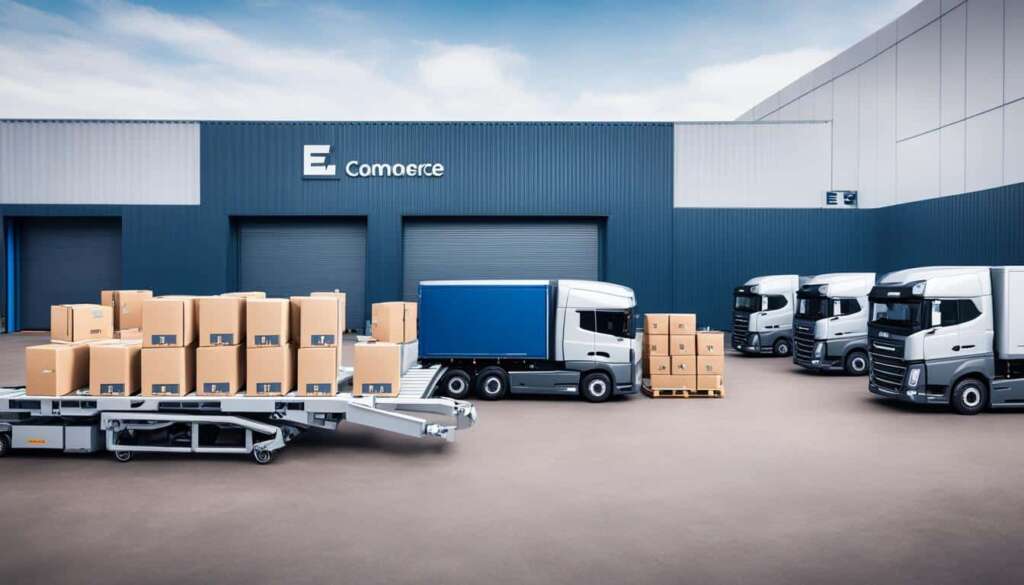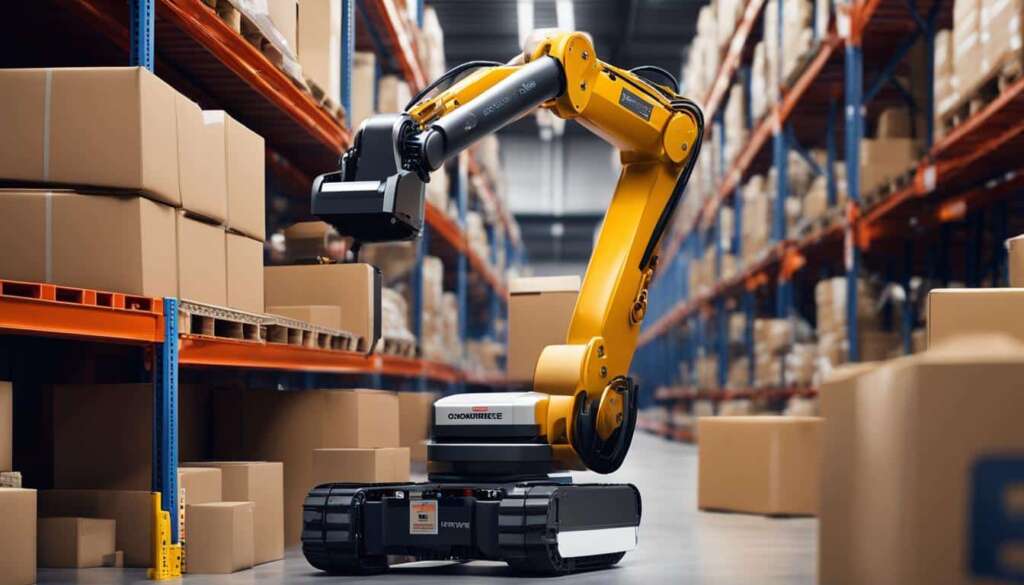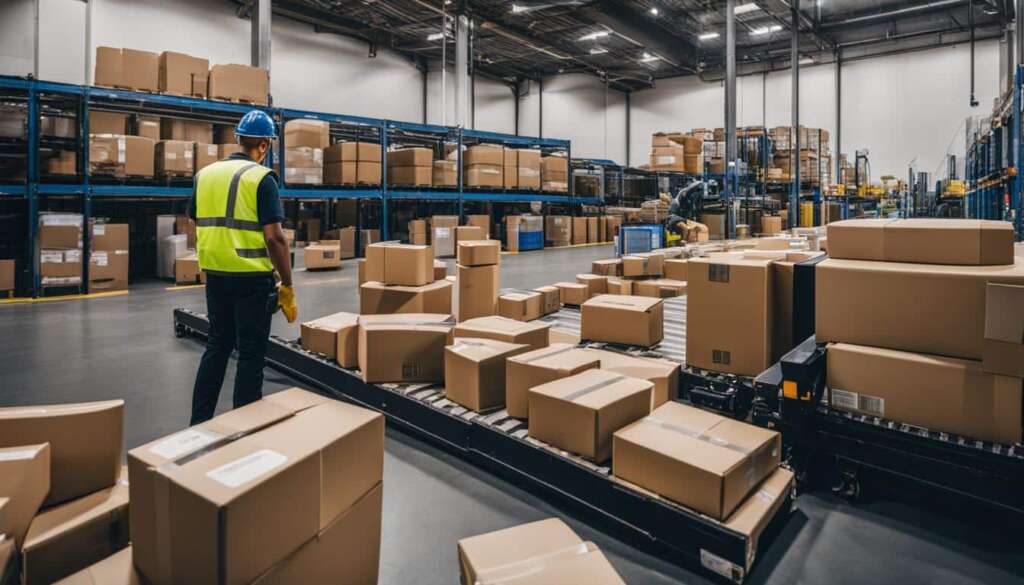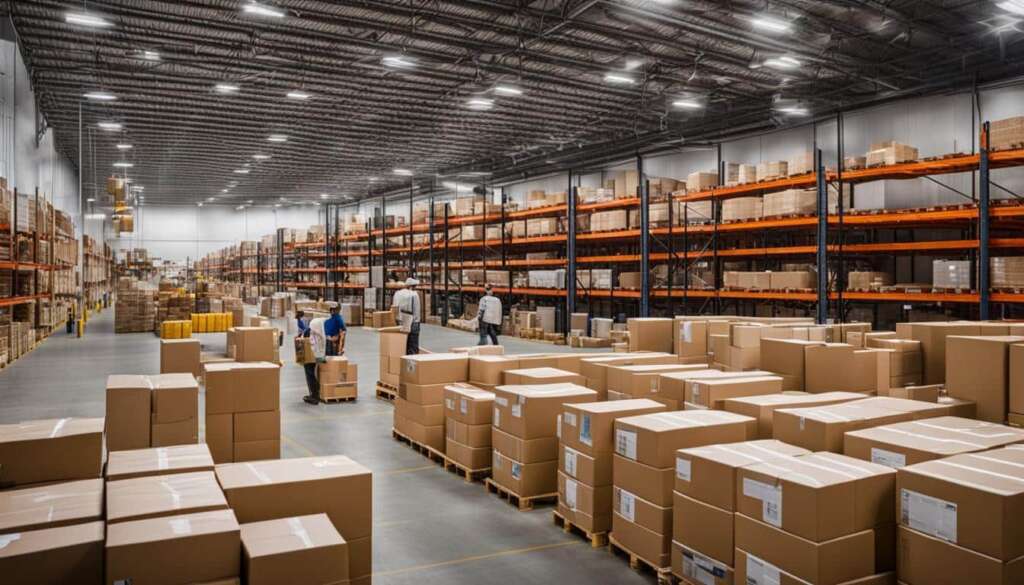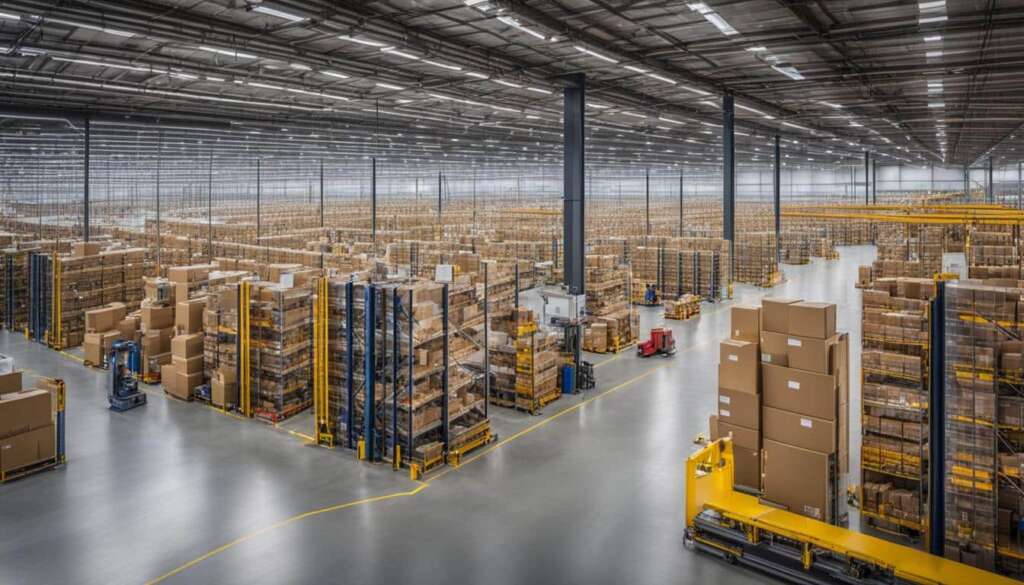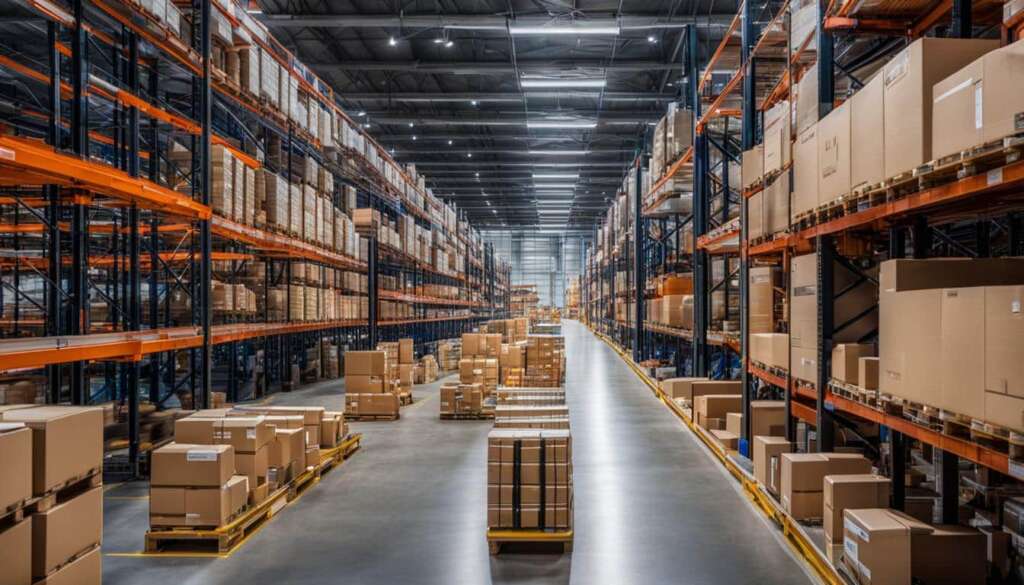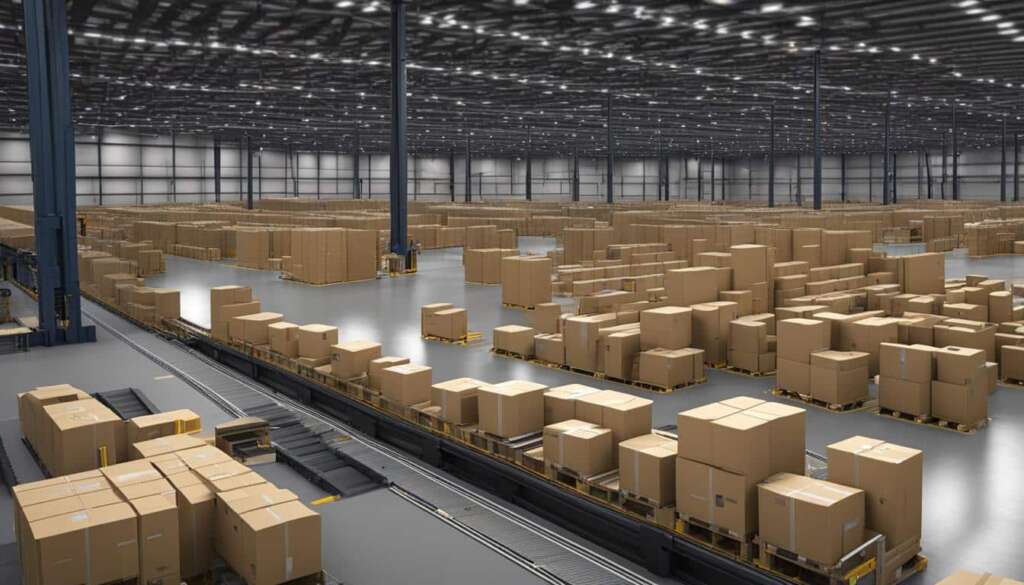Table of Contents
E-commerce warehouse solutions play a critical role in achieving operational excellence and swift fulfilment in the dynamic world of online retail. As the e-commerce industry continues to flourish, businesses are increasingly turning to innovative technologies and strategies to optimize their warehousing operations. According to a report by ABI Research, the warehouse automation market is expected to reach $51 billion by 2023, highlighting the growing importance of e-commerce warehouse solutions. By implementing automation and embracing cutting-edge technologies, businesses can overcome challenges such as labor shortages and rising service expectations.
Advantages of E-commerce Warehouse Automation
Implementing automated solutions in e-commerce warehouses brings forth a multitude of benefits. With high productivity, uninterrupted operations, error elimination, and greater storage capacity, automation revolutionizes warehouse management, enabling businesses to meet customer demands and enhance their market competitiveness.
Automated storage and order picking systems optimize the efficiency of storing and retrieving goods, as well as the transportation of products within the facility. This leads to increased productivity and streamlined operations, resulting in swift and efficient order fulfillment.
A vital advantage of automation is the ability to operate 24/7 without interruptions. By eliminating the constraints of workforce schedules, businesses can cater to the ever-increasing demand for quick and accessible service, ensuring customer satisfaction and loyalty.
“Automation optimizes storage capacity by making the most of available space, allowing businesses to store more products and efficiently manage inventory.”
One of the key advantages of e-commerce warehouse automation is the elimination of errors. Automated solutions remove the possibility of human error in various operations, including goods receipt, order picking, and dispatch. This leads to improved accuracy, reduced rework, and ultimately, enhanced customer experience.
Additionally, automation enables businesses to maximize their storage capacity. By utilizing the available space more efficiently, companies can store a greater volume of products and optimize inventory management.
“E-commerce warehouse automation enhances safety for operators, materials, and storage systems, leading to a more secure and risk-free working environment.”
Moreover, automation contributes to a safer workplace. By automating tasks that pose risks to operators, such as heavy lifting or operating machinery, businesses can minimize the likelihood of accidents and injuries. This not only ensures the well-being of employees but also safeguards the integrity of materials and storage systems.
Overall, e-commerce warehouse automation empowers businesses to adapt their processes to meet customer requirements while gaining a competitive edge in the market. By leveraging automated solutions, companies can improve operational efficiency, enhance customer satisfaction, and achieve sustainable growth.
See the diagram below for a visual representation of the advantages of e-commerce warehouse automation:
E-commerce Warehouse Automation Solutions
In e-commerce facilities, one of the key aims is to automate essential operations such as the movement of goods, product storage and retrieval, and order picking. By implementing automation technologies, companies can streamline their processes and enhance operational efficiency. Here are some of the innovative solutions that can significantly improve warehouse automation in the e-commerce industry:
1. Goods-to-person Order Picking Systems
In goods-to-person order picking systems, automated conveyors are utilized to bring products directly to the pick stations. This eliminates the need for operators to travel long distances within the warehouse, saving time and increasing productivity. By reducing the traveling time, this solution significantly improves the efficiency of the order picking process.
2. Autonomous Mobile Robots (AMRs)
Autonomous mobile robots equipped with advanced AI and machine learning technologies are revolutionizing e-commerce warehouse automation. These robots can independently make decisions and move materials as required. They optimize the movement of goods within the facility, resulting in improved efficiency and operational performance.
3. Mini-load Systems and Shuttle Systems
Mini-load systems and shuttle systems are highly efficient automated storage and retrieval systems (AS/RS). They enable rapid storage and retrieval of products, maximizing storage capacity and minimizing the time required for order picking. This not only improves productivity but also ensures accurate inventory management.
4. High-performance Pick Stations
High-performance pick stations are designed to enhance order picking efficiency. These stations are equipped with advanced technologies such as pick-to-light systems and voice-guided picking, which enable faster and more accurate order fulfillment. By optimizing the order picking process, companies can meet customer demands promptly and improve customer satisfaction.
To give you a better idea of the various e-commerce warehouse automation solutions, here’s a comprehensive table comparing their key features:
| Automation Solution | Key Features |
|---|---|
| Goods-to-person Order Picking Systems | – Automated conveyors deliver products directly to pick stations – Eliminates the need for operators to travel within the warehouse – Increases order picking efficiency and reduces labor requirements |
| Autonomous Mobile Robots (AMRs) | – AI-enabled robots autonomously make decisions and move materials – Optimizes movement of goods within the warehouse – Enhances operational efficiency and productivity |
| Mini-load Systems and Shuttle Systems | – Rapid storage and retrieval of products – Maximizes storage capacity and minimizes picking time – Improves inventory management |
| High-performance Pick Stations | – Equipped with advanced technologies such as pick-to-light and voice-guided systems – Increases order picking speed and accuracy – Enhances customer satisfaction through prompt order fulfillment |

E-commerce warehouse automation solutions significantly improve the movement of goods, product storage and retrieval, and order picking processes. By adopting these technologies, companies can achieve higher operational efficiency, minimize errors, and optimize their overall warehouse performance.
Ecommerce Warehousing Best Practices
Ecommerce warehousing plays a crucial role in optimizing the supply chain and ensuring efficient operations. Implementing best practices in warehousing can result in significant cost savings, improved customer satisfaction, and streamlined logistics. There are several key strategies that businesses can employ to enhance their ecommerce warehousing processes.
1. In-house Warehousing vs. 3PL Partnerships
When it comes to warehousing, businesses have the option to manage operations in-house or partner with third-party logistics (3PL) providers. In-house warehousing allows for full control over the process but can be costly and require substantial resources. On the other hand, outsourcing to a 3PL enables businesses to leverage the expertise and infrastructure of the provider, reducing costs and improving efficiency. The decision between in-house warehousing and 3PL partnerships should be based on the specific needs and capabilities of the business.
2. Warehouse Management Systems
To ensure smooth operations, businesses should utilize robust warehouse management systems (WMS). These systems help automate and optimize various warehousing processes such as inventory tracking, order processing, and stock management. A comprehensive WMS can provide real-time visibility into inventory levels, improve order accuracy, and streamline picking and packing operations.
3. Optimizing Storage Locations
Strategic storage locations can significantly impact shipping costs and delivery times. By analyzing customer proximity and demand patterns, businesses can identify optimal storage locations that minimize transit times and reduce transportation expenses. This approach allows for faster order fulfillment and ensures timely delivery to customers.
4. Supply Chain Optimization
An efficient ecommerce warehousing system is closely linked to supply chain optimization. By adopting data-driven approaches such as demand forecasting, businesses can optimize inventory levels, reduce stockouts, and improve order fulfillment. Supply chain optimization involves integrating various functions such as procurement, production, and distribution to create a seamless flow of goods from suppliers to customers.
5. Continuous Improvement and Innovation
Staying competitive in the ecommerce landscape requires a commitment to continuous improvement and innovation. Businesses should regularly evaluate their warehousing processes, identify areas for improvement, and implement new technologies and practices to drive efficiency. Embracing emerging trends such as robotics, automation, and machine learning can further enhance operational performance and scalability.
Implementing best practices in ecommerce warehousing can result in significant cost savings, improved customer satisfaction, and streamlined logistics.
By incorporating these best practices, businesses can optimize their ecommerce warehousing operations, reduce costs, and enhance customer satisfaction. Whether through in-house warehousing or 3PL partnerships, leveraging technology and strategic storage locations, and continuously improving processes, ecommerce businesses can create a robust and efficient warehousing system that supports growth and success.
How 3PLs Unlock Ecommerce Growth
Working with a third-party logistics (3PL) provider can unlock tremendous growth opportunities for e-commerce businesses. 3PLs offer seamless ecommerce integration and a range of services that enhance order fulfillment, inventory management, and scalability.
One of the key advantages of partnering with a 3PL is their direct integration with major e-commerce platforms, enabling smooth and efficient order processing. This integration ensures that orders are automatically synced with the 3PL’s system, eliminating the need for manual data entry and reducing the risk of errors.
A critical aspect of successful e-commerce operations is effective inventory management. 3PLs provide real-time inventory tracking, allowing businesses to monitor stock levels accurately and avoid stockouts. This real-time visibility empowers businesses to make informed decisions regarding restocking and ensures that customer orders can be fulfilled promptly and accurately.
Scalability is a crucial factor in the growth of e-commerce businesses. By outsourcing logistics to a 3PL, businesses can rapidly scale their operations without the need to invest in additional warehousing or staffing. The 3PL takes care of warehousing, inventory management, and shipping, allowing businesses to focus on their core competencies and strategic initiatives.
Furthermore, 3PLs often have multiple warehouse locations strategically placed to serve different regions. This distribution network enables faster order fulfillment, shorter transit times, and reduced shipping costs. By leveraging these warehouse locations, businesses can enhance their customer experience and gain a competitive edge.
Ultimately, partnering with a 3PL unlocks ecommerce growth by providing seamless integration, efficient order tracking, effective inventory management, scalability, and faster order fulfillment. The expertise and technology offered by 3PLs enable businesses to streamline their operations, optimize customer experience, and capitalize on growth opportunities.
| Benefits of 3PLs for Ecommerce | Ecommerce Integration | Order Tracking | Inventory Management | Scalability | Faster Order Fulfillment |
|---|---|---|---|---|---|
| Seamless integration with major e-commerce platforms | ✔ | ||||
| Real-time inventory tracking | ✔ | ||||
| Scalability without additional warehousing or staffing | ✔ | ✔ | |||
| Multiple warehouse locations for faster order fulfillment | ✔ |
Importance of Ecommerce Warehousing
Ecommerce warehousing is a critical factor in ensuring the overall success and competitiveness of an online business. It involves efficient storage and inventory management, which guarantees quick access to products for order fulfillment, leading to enhanced customer satisfaction.
One of the key advantages of effective warehousing is accurate picking and packing of orders, which significantly reduces the chances of shipping errors and returns. By maintaining order accuracy, businesses can deliver a seamless customer experience, ensuring repeat business and positive word-of-mouth recommendations.
Furthermore, leveraging external warehousing solutions, such as fulfillment centers or distribution centers, can yield cost savings and contribute to scalable growth. Fulfillment centers allow businesses to outsource their warehousing needs, avoiding the need for expensive infrastructure and resources. This approach provides flexibility and ensures that storage capacity can be easily adjusted to meet fluctuating demand.
Well-managed warehousing operations also play a vital role in efficient supply chain management. By optimizing storage and inventory processes, businesses can realize significant cost savings. Effective inventory management minimizes the risk of overstocking or shortages, reducing carrying costs and fulfilling customer demands in a timely manner.
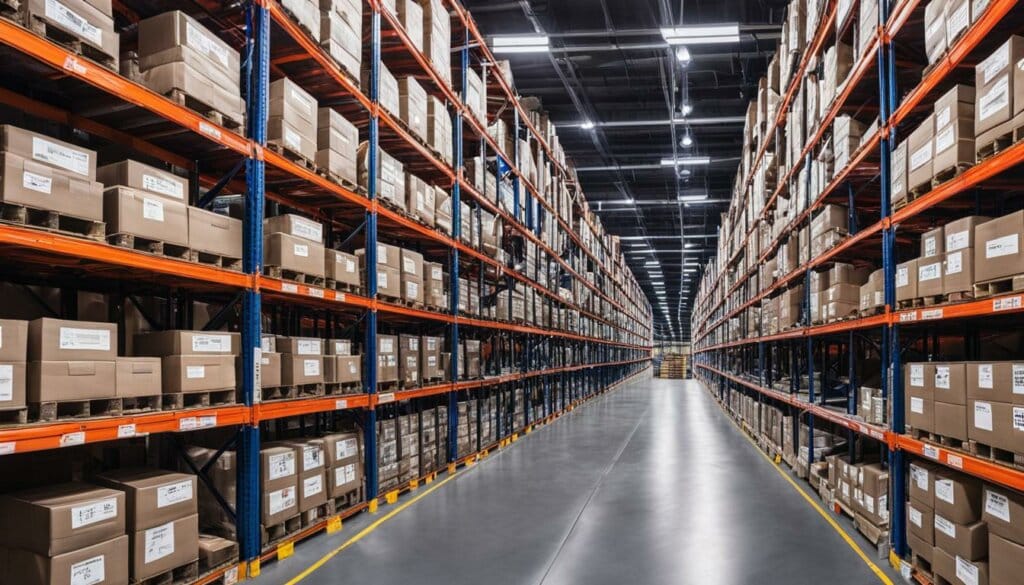
In summary, robust ecommerce warehousing practices, including efficient storage and inventory management, directly impact customer satisfaction, order accuracy, and cost savings. By prioritizing these aspects and utilizing external warehousing solutions, businesses can streamline their operations, deliver exceptional customer experiences, and achieve sustainable growth in the competitive e-commerce landscape.
Conclusion
Ecommerce warehousing is an essential element for the success of any online business. By implementing advanced automation technologies and forming strategic partnerships with third-party logistics (3PL) providers, businesses can achieve high levels of operational efficiency and customer satisfaction. Outsourcing warehousing and fulfillment allows companies to focus on their core competencies while leveraging the expertise and resources of experienced 3PLs.
Efficient warehousing management ensures accurate inventory tracking, enabling businesses to fulfill orders faster and with greater precision. This results in improved customer satisfaction and loyalty, as well as reduced shipping errors and returns. Moreover, by adopting effective ecommerce warehousing strategies, businesses can achieve significant cost savings through streamlined operations and optimized inventory management.
As the ecommerce industry continues to evolve, businesses that prioritize efficient warehousing practices will unlock growth opportunities and maintain their competitive edge. The ability to adjust to market demands quickly, optimize operational processes, and provide exceptional customer experiences will position businesses for long-term success. By embracing ecommerce warehousing, companies can not only meet customer expectations but also seize growth opportunities and thrive in the ever-expanding online marketplace.
FAQ
What are e-commerce warehouse solutions?
E-commerce warehouse solutions are strategies and technologies implemented in the logistics industry to improve operational efficiency and achieve swift fulfillment for online orders.
What are the advantages of e-commerce warehouse automation?
E-commerce warehouse automation offers several benefits, including high productivity, uninterrupted operations, error elimination, and greater storage capacity.
What operations can be automated in e-commerce warehouses?
The most common operations to be automated in e-commerce warehouses include the movement of goods, product storage and retrieval, and order picking. Various automated solutions, such as high-performance pick stations and autonomous mobile robots, are available.
What are the best practices for e-commerce warehousing?
Best practices for e-commerce warehousing involve optimizing the supply chain, considering in-house warehousing or partnering with third-party logistics (3PL) providers, and strategically selecting storage locations based on customer proximity.
How do 3PLs unlock growth in e-commerce?
Third-party logistics (3PL) providers offer features such as e-commerce platform integration, real-time inventory tracking, and automatic order syncing, enabling businesses to scale their operations efficiently, improve inventory management, and achieve faster order fulfillment.
What is the importance of e-commerce warehousing?
Effective e-commerce warehousing is crucial for customer satisfaction and cost savings. It ensures accurate storage and inventory management, reduces shipping errors, and contributes to efficient supply chain management.
What are the key takeaways of e-commerce warehousing?
E-commerce warehousing solutions optimize operational efficiency, enhance customer satisfaction, and unlock growth opportunities in the ever-evolving e-commerce industry.

